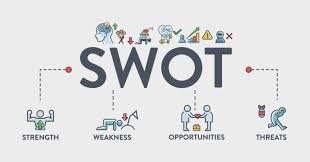A personal SWOT strategy is a self-assessment tool individuals use to evaluate their strengths, weaknesses, opportunities, and threats to their personal and professional goals.
SWOT stands for:

Strengths: These are the positive attributes and qualities that you possess. They are internal factors that contribute to your personal and professional success. Examples of strengths could include specific skills, knowledge, experience, or unique characteristics that set you apart.
Weaknesses: Weaknesses are areas where you may have limitations or areas for improvement. These are also internal factors but represent aspects that might hinder your progress or achievement of your goals.
Opportunities: Opportunities are external factors that can be leveraged to your advantage. They are favorable circumstances or situations that you can tap into to help you reach your objectives.
Threats: Threats are external factors that could hinder your progress or pose challenges to achieving your goals. These could be changes in the external environment, competition, or obstacles you must overcome.
To create a personal SWOT strategy, follow these steps:
- Self-Reflection: Reflect on your strengths, weaknesses, opportunities, and threats. Be honest with yourself and try to identify these factors objectively.
- List Your Strengths: List your strengths, considering both hard skills (e.g., technical expertise) and soft skills (e.g., communication, leadership).
- Identify Your Weaknesses: Be aware of your weaknesses and areas for improvement. This might include skills you need to develop or personal traits you want to address.
- Recognize Opportunities: Look for external opportunities that align with your goals. These could be networking opportunities, industry trends, or openings for personal growth.
- Assess Threats: Consider potential threats or obstacles that could impede your progress. This might involve competition, economic factors, or personal challenges.
- Create an Action Plan: Develop a strategic action plan based on your SWOT analysis. Utilize your strengths to take advantage of opportunities and address your weaknesses and threats. Set specific and achievable goals, along with actionable steps to achieve them.
- Monitor Progress: Regularly review and update your SWOT strategy as you progress toward your goals. Stay flexible and adjust your plan as needed based on changing circumstances.
A personal SWOT strategy can help you gain insights into your current situation, make informed decisions, and align your efforts with your objectives. It can be especially beneficial when setting career goals, seeking personal development, or planning a career transition. Remember that self-awareness and continuous assessment are essential for personal and professional growth.
